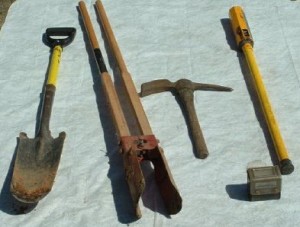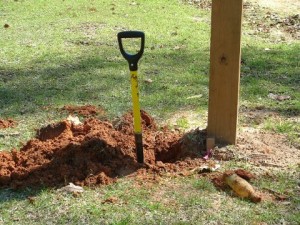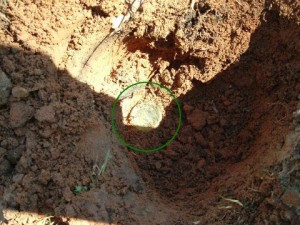The Lost Art of Locating Property Corners
Locating Property Corners
Article by Glen Tanner, Professional Land Surveyor, Copyright 2011, Used by Permission
 The art of finding property cornersis being lost. The following picture shows what inspired this article. The two rebar, a #4 rebar and a #5 rebar, shown in the photo to the right are 1.9 feet apart and set in 1994 or after according to the client. Did surveyors not have Minimum Technical Standards and magnetic locators or at least an aqua locator in 1994? How many of you surveyors had your crew come in and the party chief tells you that they had to set an iron because they couldn’t find an iron pin? How many of you accept this or do you check it out yourself?There is a lot of iron ore in the rocks around these two rebar, which will mess with magnetic locators if your not patient.(Photos taken 03-16-11)
The art of finding property cornersis being lost. The following picture shows what inspired this article. The two rebar, a #4 rebar and a #5 rebar, shown in the photo to the right are 1.9 feet apart and set in 1994 or after according to the client. Did surveyors not have Minimum Technical Standards and magnetic locators or at least an aqua locator in 1994? How many of you surveyors had your crew come in and the party chief tells you that they had to set an iron because they couldn’t find an iron pin? How many of you accept this or do you check it out yourself?There is a lot of iron ore in the rocks around these two rebar, which will mess with magnetic locators if your not patient.(Photos taken 03-16-11) Almost all survey crews today have a magnetic pin finder and either a bushaxe or machete. But for some jobs, these aren’t adequate. As a Professional Surveyor I use the tools shown to the left. Without them, how do you expect your crews to locate property corners if they can’t even dig them up? The magnetic locator in this picture is about 17 years old. It is held together with JB-weld and duck tape. The reason I don’t buy a new one is because new isn’t always better, when it growls I understand why, when it screams I know why, most of all I’ve had very good luck with it finding corners. I have alwaysused an aqua locator, the small black box in the picture, near fences or when I doubt what the magnetic locator is doing. An aqua locator works as deep as 2 feet. I go thru a sharp shooter a year, the pick is for hard ground, the post hole diggers are for when the sharp shooter doesn’t work getting out the dirt.
Almost all survey crews today have a magnetic pin finder and either a bushaxe or machete. But for some jobs, these aren’t adequate. As a Professional Surveyor I use the tools shown to the left. Without them, how do you expect your crews to locate property corners if they can’t even dig them up? The magnetic locator in this picture is about 17 years old. It is held together with JB-weld and duck tape. The reason I don’t buy a new one is because new isn’t always better, when it growls I understand why, when it screams I know why, most of all I’ve had very good luck with it finding corners. I have alwaysused an aqua locator, the small black box in the picture, near fences or when I doubt what the magnetic locator is doing. An aqua locator works as deep as 2 feet. I go thru a sharp shooter a year, the pick is for hard ground, the post hole diggers are for when the sharp shooter doesn’t work getting out the dirt.
How deep does your crew dig to find a property corner? I personally go until I’m absolutely sure.
One open-top iron pipe found – the original property corner on this subdivision lot.
The deepest I have ever had to dig to locate an iron is 3 feet. I have found old irons that a tree has grown over or around as much as a foot in the tree. This lot was a 100 by 200 according to the plat, but on the ground along the road it measured 98 feet, along the rear of lot, 96 feet and 198 feet in depth. Boy, this one sure matched the plat. This lot originally was an Autauga county gully that has been filled. The plat was recorded in 1969 and all lots shown on the plat along the south line were shown to be 160 feet plus or minus. Do you believe the rest of the subdivision is going to match the plat?
Finding instead of setting property corners
 Ask anyone that knows me, they will tell you, before Glen Tanner quits looking and sets an iron, the ground will look like it has been attacked by armadillos and groundhogs. The art and skill of finding property corners is disappearing. We as surveyors need to teach and emphasize the need to look for and locate property corners. I find about 90% of property corners in old subdivisions. It isn’t always easy and some of the time it is very time consuming. I have been known to go back on a different day, after having had time to look at my field data, and start fresh with a better idea on where to look before setting an iron pin. It does work but it takes time, it is something we don’t allow ourselves or allow our survey crews – time to look.
Ask anyone that knows me, they will tell you, before Glen Tanner quits looking and sets an iron, the ground will look like it has been attacked by armadillos and groundhogs. The art and skill of finding property corners is disappearing. We as surveyors need to teach and emphasize the need to look for and locate property corners. I find about 90% of property corners in old subdivisions. It isn’t always easy and some of the time it is very time consuming. I have been known to go back on a different day, after having had time to look at my field data, and start fresh with a better idea on where to look before setting an iron pin. It does work but it takes time, it is something we don’t allow ourselves or allow our survey crews – time to look.

